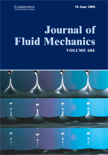
JOURNAL OF FLUID MECHANICS
Scope & Guideline
Driving excellence in fluid mechanics research.
Introduction
Aims and Scopes
- Fluid Dynamics Fundamentals:
The journal emphasizes fundamental studies in fluid dynamics, including the mathematical modeling of fluid flows, stability analysis, and turbulence theory. - Experimental Fluid Mechanics:
Research involving experimental techniques to investigate fluid behavior, including flow visualization, particle image velocimetry (PIV), and laser Doppler anemometry. - Computational Fluid Dynamics (CFD):
Papers that utilize numerical simulations to solve complex fluid flow problems, including turbulence modeling, heat transfer, and multiphase flows. - Interfacial and Multiphase Flows:
Studies focusing on the dynamics of interfaces, including capillary effects, droplet dynamics, and the interactions of different phases in fluids. - Biofluid Mechanics and Biological Applications:
Research that applies fluid mechanics principles to biological systems, exploring topics such as swimming organisms, blood flow, and respiratory dynamics. - Environmental Fluid Mechanics:
Investigations into fluid mechanics phenomena relevant to environmental science, including oceanic flows, atmospheric dynamics, and sediment transport. - Energy and Propulsion Systems:
Research contributing to the understanding of energy systems, including flow around vehicles, wind turbines, and heat exchangers.
Trending and Emerging
- Machine Learning and Data-Driven Approaches:
An increasing number of studies are utilizing machine learning techniques to model fluid flows, optimize simulations, and analyze complex data sets, indicating a shift towards integrating artificial intelligence in fluid mechanics. - Multiscale and Multiphysics Modeling:
Research that combines various scales and physical phenomena, such as fluid-structure interactions and coupled thermal dynamics, is on the rise, reflecting the complexity of real-world applications. - Active and Passive Control Techniques:
Studies exploring active control methods for turbulence reduction or flow optimization, as well as passive control strategies using surface modifications, are gaining traction. - Bio-inspired Fluid Mechanics:
Research inspired by biological systems, such as swimming mechanisms in animals and plants, is increasingly popular, leading to innovations in bio-inspired designs and applications. - Environmental and Geophysical Fluid Mechanics:
There is a growing interest in fluid dynamics applications related to environmental issues, such as climate change impacts, pollutant dispersion, and energy harvesting from natural flows. - Non-Newtonian Fluid Dynamics:
The study of non-Newtonian fluids, particularly in industrial applications and biological systems, is emerging as a significant area of research due to its relevance in various engineering fields.
Declining or Waning
- Classical Hydrodynamics:
Studies focused solely on classical hydrodynamics without modern applications or interdisciplinary connections have seen a decline as researchers explore more complex fluid dynamics scenarios. - Linear Stability Theory:
While still important, the frequency of papers solely dedicated to linear stability theory has diminished as researchers increasingly focus on nonlinear effects and real-world applications. - Simplistic Models of Turbulence:
Research employing overly simplistic turbulence models has decreased in favor of more sophisticated approaches, including machine learning and data-driven methods. - Static Fluid Mechanics:
Research focused on static or equilibrium states of fluids has declined in favor of dynamic studies that account for time-dependent and transient behaviors.
Similar Journals

Fluid Dynamics
Driving innovation in fluid dynamics research.Fluid Dynamics is a distinguished journal that has been at the forefront of research in the field of fluid flow and transfer processes since its inception in 1966. Published by MAIK NAUKA/INTERPERIODICA/SPRINGER, this journal serves as a valuable platform for engineers, scientists, and researchers dedicated to advancing the understanding of mechanical and fluid dynamic phenomena. With a Q3 ranking in key categories such as Fluid Flow and Transfer Processes, Mechanical Engineering, and Physics and Astronomy, Fluid Dynamics holds a significant position in the academic community, attracting submissions that push the boundaries of knowledge and application. Although it does not currently offer open access options, the journal is recognized for its robust editorial standards and impactful contributions to the field, making it essential reading for anyone involved in fluid dynamics research. Given its consistent publication through to 2024, Fluid Dynamics continues to inspire innovation and collaboration in an ever-evolving scientific landscape.

INTERNATIONAL JOURNAL OF HEAT AND FLUID FLOW
Championing Rigorous Research in Heat Transfer and Fluid DynamicsFounded in 1979, the INTERNATIONAL JOURNAL OF HEAT AND FLUID FLOW is a premier publication in the fields of mechanical engineering, fluid dynamics, and heat transfer, published by Elsevier Science Inc. With an impressive impact factor and ranking in the Q1 category for Mechanical Engineering and Q2 for Condensed Matter Physics and Fluid Flow and Transfer Processes, this journal is highly regarded for its rigorous peer-reviewed articles that contribute significantly to the advancement of knowledge in these critical areas. Researchers, professionals, and students can access cutting-edge studies that explore the intricacies of thermal and fluid systems, ensuring they stay at the forefront of scientific exploration. The Scopus rankings further affirm its role as a leading source of impactful research, with significant placements in crucial academic categories. Join an active community of scholars committed to innovation and excellence in the exploration of heat and fluid flow phenomena.
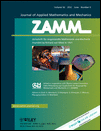
ZAMM-Zeitschrift fur Angewandte Mathematik und Mechanik
Unveiling Innovative Solutions in Applied Mathematics and Mechanics.ZAMM-Zeitschrift fur Angewandte Mathematik und Mechanik is a distinguished journal published by WILEY-V C H VERLAG GMBH, committed to advancing the fields of applied mathematics and computational mechanics since its inception in 1921. With a significant trajectory spanning nearly a century, this journal serves as a critical platform for the dissemination of high-quality, peer-reviewed research that encompasses theoretical and practical advancements in these disciplines. Currently holding a Q3 category in Applied Mathematics and Q2 in Computational Mechanics as per the 2023 rankings, ZAMM demonstrates its prominence with measurable impact in both fields, reflected in its Scopus rankings: 202 out of 635 journals in Applied Mathematics and 32 out of 89 in Computational Mechanics. Although it does not provide open access, ZAMM remains invaluable to researchers, professionals, and students seeking to deepen their understanding and contribute to the evolving landscape of mathematical applications in engineering contexts. Explore the latest insights and methodologies that push the boundaries of applied mathematics and mechanics by engaging with ZAMM’s comprehensive range of articles.

EXPERIMENTAL THERMAL AND FLUID SCIENCE
Exploring the dynamics of heat and fluid with cutting-edge studies.EXPERIMENTAL THERMAL AND FLUID SCIENCE is a prestigious academic journal published by Elsevier Science Inc, dedicated to advancing the fields of thermal and fluid sciences. With a strong focus on innovative experimental research, it plays a crucial role in disseminating new knowledge and techniques across multiple domains, including Aerospace Engineering, Chemical Engineering, Fluid Flow and Transfer Processes, Mechanical Engineering, and Nuclear Engineering. Holding a notable impact factor and ranking in the Q1 quartile across these categories since 2023, the journal is recognized for its high-quality contributions, which appeal to a diverse audience of researchers, industry professionals, and students alike. Additionally, with dedicated coverage from its inception in 1988 to projections extending through 2025, EXPERIMENTAL THERMAL AND FLUID SCIENCE provides a vital platform for sharing advancements in experimental techniques and findings that shape the future of engineering and applied sciences.
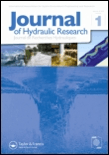
JOURNAL OF HYDRAULIC RESEARCH
Fostering Knowledge for a Water-Smart WorldJOURNAL OF HYDRAULIC RESEARCH, published by TAYLOR & FRANCIS LTD, serves as a leading platform for the dissemination of groundbreaking research in the fields of civil and structural engineering as well as water science and technology. With its inception in 1963 and a focus that spans to 2024, the journal holds a notable reputation, categorized in the Q2 quartile in both engineering and environmental sciences, indicating its significant impact on contemporary research. It is indexed under ISSN 0022-1686 and E-ISSN 1814-2079, allowing for a comprehensive reach to professionals and scholars worldwide. The journal regularly features high-quality articles, fostering an academic community dedicated to innovative hydraulic research, sustainable water management, and engineering advancements. Researchers and practitioners benefit from the rigorous peer-review process that ensures the highest standards of scholarly excellence in every published work. As part of its commitment to knowledge dissemination, JOURNAL OF HYDRAULIC RESEARCH remains an essential resource for anyone engaged in the dynamic interplay of water and engineering sciences.

Journal of the Serbian Society for Computational Mechanics
Exploring New Dimensions in EngineeringJournal of the Serbian Society for Computational Mechanics, published by the Serbian Society for Computational Mechanics, is a vital platform for advancing research and knowledge in the field of computational mechanics. Established in 2012, this journal serves the academic community by providing a forum for innovative studies, methodologies, and applications within computational mechanics, presenting valuable insights for researchers, professionals, and students alike. With an ISSN of 1820-6530 and a ranking of Q4 in Computational Mechanics, it carries an essential influence in the engineering realm, despite its current rank of 71 out of 89. The journal's commitment to scholarly excellence aims to foster collaboration and encourage interdisciplinary research, making it an important resource for those invested in the evolving landscape of computational methodologies. Although the journal currently does not offer Open Access options, it remains dedicated to disseminating knowledge that will resonate within the local and global scientific community.

Physical Review Fluids
Elevating Fluid Mechanics to New HeightsPhysical Review Fluids is an esteemed journal published by the American Physical Society, focusing on the intricate and essential field of fluid dynamics. With an impressive Q1 ranking in categories such as Computational Mechanics, Fluid Flow and Transfer Processes, and Modeling and Simulation, this journal serves as a pivotal resource for researchers and professionals seeking to disseminate high-quality and innovative research findings. The journal's scope encompasses a broad spectrum of topics within fluid mechanics, promoting advancements in theoretical, computational, and experimental methodologies. Although it is not an open-access journal, its publications are critically well-received, underpinned by its strong standing in the Scopus rankings which place it in the top percentiles across various relevant fields. Physical Review Fluids has been a foundational platform for scholars to share their discoveries from 2016 through 2024, making it an indispensable asset in the ongoing evolution of fluid dynamics research.

MECCANICA
Fostering Collaboration in Cutting-edge ResearchMECCANICA, an esteemed journal published by Springer, stands at the forefront of research in the fields of Condensed Matter Physics, Mechanical Engineering, and Mechanics of Materials. Established in 1966 and continuing through 2024, this journal provides a robust platform for the dissemination of innovative research and advancements in these increasingly interconnected domains. With an impressive 2023 ranking placing it in the Q2 category across multiple fields, MECCANICA boasts a Scopus rank of #198 in Mechanical Engineering, #150 in Condensed Matter Physics, and #141 in Mechanics of Materials, highlighting its significance and influence within the scholarly community. The journal aims to foster dialogue among researchers, professionals, and students, facilitating the exchange of cutting-edge ideas and methodologies crucial for overcoming contemporary engineering and physics challenges. Readers can access a wealth of knowledge through its comprehensive articles, and while it does not currently offer open access, the journal remains instrumental in shaping the future of engineering and physical sciences.
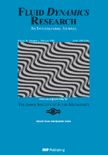
FLUID DYNAMICS RESEARCH
Fostering Collaboration in Fluid Dynamics ResearchFLUID DYNAMICS RESEARCH, published by IOP Publishing Ltd, is a pivotal journal dedicated to advancing the understanding of fluid dynamics through interdisciplinary research that spans several domains including mechanical engineering and physics. With an ISSN of 0169-5983 and E-ISSN 1873-7005, this journal provides a vital platform for researchers aiming to disseminate new findings and theoretical advancements in fluid flow and transfer processes. As of 2023, FLUID DYNAMICS RESEARCH holds a commendable position within the academic community, ranked Q3 in fluid flow and transfer processes, mechanical engineering, and miscellaneous physics and astronomy categories. The journal showcases a diverse array of articles that not only inspire collaboration among professionals and students but also ensure that theoretical and experimental studies are accessible for further development in the field. Operating from the United Kingdom, the journal offers a unique opportunity for scholars worldwide to contribute to the vibrant community dedicated to understanding the complexities of fluid dynamics, even as it anticipates converging its years of research from 1986 to 2024.
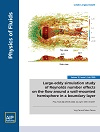
PHYSICS OF FLUIDS
Bridging Academia and Industry in Fluid ResearchPHYSICS OF FLUIDS is a premier journal published by AIP Publishing that serves as a vital resource for the fluid mechanics community. With an impressive impact factor and a consistent ranking in the Q1 quartile across multiple related disciplines—including Computational Mechanics, Condensed Matter Physics, Fluid Flow and Transfer Processes, Mechanical Engineering, and Mechanics of Materials—this journal is renowned for disseminating high-quality research in the dynamic field of fluid dynamics. Covering a wide range of topics, from fundamental fluid mechanics to advanced computational modeling, PHYSICS OF FLUIDS plays a crucial role in advancing understanding and fostering innovation in both academic and industrial applications. With its strong reputation and significant readership, this journal is essential for researchers, professionals, and students seeking to stay updated on the latest developments in fluid physics.